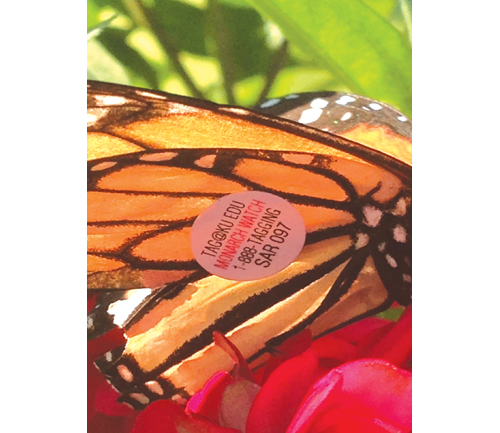Tagging program shows butterfly traveled a long way to North Fork

Eileen Kapell rushed to get a camera after she spotted a monarch butterfly — the first of the season — resting among the zinnias in her front garden Sunday morning. But as she lay down to take the photo, the Greenport resident noticed something odd. There was a circular white patch stuck to the butterfly’s wing.
“I thought, how terrible,” she said. “I thought it was one of those little tags you see on fruit.”
Thankfully, the sticker wasn’t litter; it was a tracking tag from a Kansas-based monarch research group.
“I’ve seen tagged bass, I’ve seen tagged birds, but never tagged butterflies,” Ms. Kapell said.
Sunday’s monarch was one of more than 1 million butterflies that have been tagged and identified through Monarch Watch, a University of Kansas program that works to better understand their extensive migration patterns and how to protect the species.
Monarch Watch started in 1992 and was an instant success, said founder and KU professor Orley “Chip” Taylor.
“People want to get involved,” Mr. Taylor told The Suffolk Times. “People are interested in the environment, they’re interested in science, they’re interested in making a difference.”
In its first year, the program had nearly 1,000 volunteers in Kansas and Texas, he said. Now, nearly 22 years later, Monarch Watch has expanded to include volunteers from across the nation and in Mexico.
The tracking group sends out sheets of small circular tags for volunteers to attach to the center of a butterfly’s hind wing, Mr. Taylor said. Those who find a tagged butterfly can call the toll-free number to report where it appeared.
Each fall, monarchs travel hundreds of miles from the Northeast and Canada down to Mexico, where winters are milder.
While Monarch Watch is still analyzing the data compiled so far, the initial results have been surprising, Mr. Taylor said.
Last year, two butterflies traveled from St. John in New Brunswick, Canada, to Mexico over a two-and-a-half month journey, he said. And the larger picture shows that the butterflies’ migrations are not as dependent on weather as biologists had thought.
“The overarching trend is these monarchs are moving based on some celestial change that we’re not sure of yet,” Mr. Taylor said, adding that the lowering angle of the sun appears to trigger the migration.
Knowing more about migration patterns helps biologists understand the species, especially ways to boost conservation efforts, Mr. Taylor said.
“The habitat for monarch butterflies and other pollinators is changing so rapidly,” he said.
Monarch Watch activities now include education programs in schools and it has even branched out into selling milkweed, a plant that provides a habitat for the butterflies, he said. Still, tagging remains the group’s biggest focus.
Ms. Kapell said she called the toll-free number to report the sighting and is curious to know exactly where her butterfly came from.
While the butterfly’s exact path hasn’t been determined yet, workers at Monarch Watch said the tag found on the butterfly’s wing was issued to the Insectarium in Montreal, Quebec — more than 300 miles north of where it was found.
Many of the tagged butterflies that are located are found dead, she learned. But the one that flew into her garden was likely just beginning its migration, having crossed Long Island Sound from the Connecticut or Massachusetts coast.
“He took off on his merry way,” Ms. Kapell said. “This guy’s still on whatever journey he’s on.”








